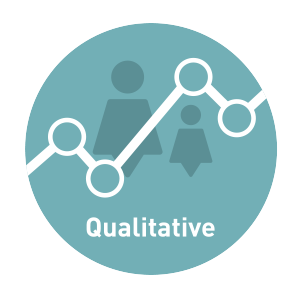
QUALITATIVE DATA USES
Qualitative research methods are useful for assessing community needs, designing prevention campaigns, planning and evaluating interventions, and engaging community actors via participatory research. They are also useful in designing and field-testing questionnaires, and in interpreting quantitative research findings. Qualitative methods can provide deeper insight into meaning, motivations and dynamics around women and girls’ empowerment. The table below provides an illustrative list of commonly methods for qualitative data collection.
QUALITATIVE DATA COLLECTION METHODS
| Method | When to use it | Key considerations when using this method to measure empowerment |
|---|---|---|
| FOCUS GROUP DISCUSSIONS | Focus group discussions (FGDs) are useful for capturing information on attitudes or opinions and why they are held, unpacking the progress and achievements of a program, and when different perspectives and points of views of stakeholders need to be explored. They are useful for collecting data on the empowerment dimensions of decision-making, critical consciousness, and norms. |
|
| IN-DEPTH INTERVIEWS | In-depth interviews are well suited to collecting data on social norms, attitudes and behaviors, as well processes of change, and nuances around decision-making. Interviews are also useful for collecting data on individual as opposed to collective opinions. The data captured is often valuable for triangulating or confirming data captured by other methods. |
|
| EMBEDDED ETHNOGRAPHY | Embedded ethnography is used to understand an ongoing process or situation. It is useful for understanding empowerment in a holistic way to see how different elements interact in a situation. Embedded ethnography also provides direct information about behavior of individuals and groups, rather than relying on what people said they did, and is helpful in identifying unanticipated outcomes. |
|
| BODY MAPPING | Body mapping is an interactive tool to obtain visual representation of women and girls ability to assert choice and articulate voice over resources (including bodily integrity). It is most valuable at the formative stage to understand the link between resources and expressions of agency. Body mapping can be used at the project and community level. |
|

